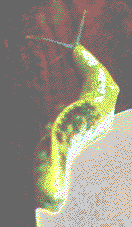
This slug was exploring after a rain. The feelers help it find its way through the forest.
The two tallest trees in the park are located five miles west of Highway 101 on the Mattole Road at the Big Trees Area. They are the "Tallest" Tree and the Giant Tree. The Tallest Tree is the tallest in the park at 360 feet. It is not, however, the tallest in the world. The nearby Giant Tree is between 357 and 363 feet. It is difficult to measure because its top is not visible. The top is hidden in a tangle of limbs. The Giant Tree was designated the Champion Coast Redwood by the American Forestry Association in 1991.
[Top]
The tallest measured tree in the world is located in Redwood National Park, north of Humboldt Redwoods State Park. The tallest tree was measured at 367.8 feet. There have been reports of taller trees, but the measurements have yet to be confirmed.
[Top]
There are four Drive Thru Trees in California. The closest one to Humboldt Redwoods is in the small town of Myers Flat, four miles south of the Visitor Center. It is privately owned and there is a fee to drive through it. Another tree that you may drive through is located in the town of Klamath, a two hour drive north of Humboldt Redwoods. A third Drive Thru Tree is located in Leggett, a one hour drive south of the park. The fourth tree is a giant sequoia and is located near Sequoia National Park.
[Top]
It occasionally snows here. The higher elevations around Grasshopper Mountain and the Bull Creek watershed receive more snow than the river canyons. Coastal breezes coming up the river canyons keep the temperature slightly warmer and the snow that falls melts quickly, usually within a day or two. Really deep, heavy snows are rare. The redwood trees do not tolerate long periods of freezing temperatures or snow very well. They thrive on the heavy rainfall and relatively mild winter climate.
[Top]
The park averages 65 inches a year, but some areas receive more rain. The Bull Creek watershed is on the "rain shadow" side of the coastal mountains. Panther Gap, at the western edge of the park, receives very high rainfall, often up to 100 or more inches a year.
[Top]
A banana slug is a large yellow slug that inhabits redwood forests. They can grow to be quite large, often over 6 inches long. Coloration can vary, with some slugs having dark spots and others being completely brown. Most banana slugs are solid yellow. They feed on vegetation and are commonly seen after a rain.

This slug was exploring after a rain. The feelers help it find its way through the forest.
[Top]
There are black bears in the park. There are no wild grizzly bears in California. They have been extinct in this state since 1922. Black bears are primarily vegetarians and may been seen in late summer frequenting the fruit orchards on the old homestead sites in the park. They also eat blackberries and will dig up wasp nests to eat the insects. Campers should never feed bears as the animals will learn this behavior and become a problem.
[Top]
Mountain lions do inhabit the park. They are rarely seen by visitors because they prefer to be in the places far away from people. Lions are also called cougars, panthers and pumas. They hunt small mammals, but their preferred prey is deer.
[Top]
A redwood tree can use as much as 500 gallons per day. The trees lose some water by transpiration, a process where water is evaporated from the leaves. The trees also store some water in the trunk. Much of the water comes from the heavy rainfall, but some comes from fog which condenses on the leaves and drips to the ground, where it is taken up by the tree's roots.
[Top]
The number of houses that can be built from one tree depends a lot on the size of the tree. For example, the Dyerville Giant was 370 feet tall and probably weighed a million pounds. The wood from this tree alone could build approximately 30 two-story houses.
[Top]
There are several good places to swim. Bull Creek is not really deep enough to swim in. However, there are plenty of places deep enough to wade in or just sit in and soak on a hot day.
Descriptions of local swimming holes may be found on the activities page. Use your Back button to return here.
[Top]
Fishing in the summer is limited to squawfish only. In the winter, salmon and steelhead fishing is popular. Check with the Department of Fish and Game for current fishing conditions. You may get north coast river information by calling (707)442-4502. (Pacific Standard Time)
[Top]
There are small stores in the towns of Myers Flat, Miranda and Redcrest. These towns are all within the park boundaries. Larger supermarkets may be found in the towns of Fortuna, 30 miles north, or Garberville, 22 miles south of the Visitor Center.
[Top]
You may call the park at (707) 946-2409.
Or, call the Visitor Center at (707) 946-2263.
We are on Pacific Standard Time.
Back to Humboldt Redwoods State Park Home Page.
http://www.northcoast.com/~hrsp/faqs.html
Revised: 23 November 1996
Copyright © 1996 Humboldt Redwoods Interpretive Association
hrsp@northcoast.com
